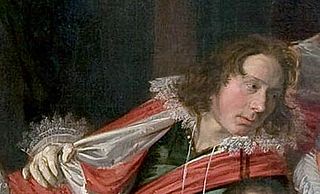
Cornelis Corneliszoon van Haarlem, Dutch Golden Age painter and draughtsman, was one of the leading Northern Mannerist artists in the Netherlands, and an important forerunner of Frans Hals as a portraitist.

Schutterij refers to a voluntary city guard or citizen militia in the medieval and early modern Netherlands, intended to protect the town or city from attack and act in case of revolt or fire. Their training grounds were often on open spaces within the city, near the city walls, but, when the weather did not allow, inside a church. They are mostly grouped according to their district and to the weapon that they used: bow, crossbow or gun. Together, its members are called a Schuttersgilde, which could be roughly translated as a "shooter's guild". It is now a title applied to ceremonial shooting clubs and to the country's Olympic rifle team.

The Banquet of the Officers of the St George Militia Company in 1616 refers to the first of several large schutterstukken painted by Frans Hals for the St. George civic guard of Haarlem, and today is considered one of the main attractions of the Frans Hals Museum there.

The Banquet of the Officers of the St Adrian Militia Company in 1627 refers to a schutterstuk painted by Frans Hals for the St. Adrian civic guard of Haarlem. Today it is considered one of the main attractions of the Frans Hals Museum.

The Banquet of the Officers of the St George Militia Company in 1627 refers to a schutterstuk painted by Frans Hals for the St. George civic guard of Haarlem, and today is considered one of the main attractions of the Frans Hals Museum there.

Jacob Druyvesteyn was a Dutch lawyer and mayor of Haarlem.
Dirck Dicx, was a Dutch Golden Age brewer in Haarlem who moved to Brazil.

Lambert Woutersz (1602–1655), was a Dutch Golden Age brewer of Haarlem.

François Wouters, was a Dutch Golden Age brewer and mayor of Haarlem.

Pieter Jacobsz Schout, was a Dutch Golden Age mayor of Haarlem.

Cornelis Jacobsz Schout, was a Dutch Golden Age member of the Haarlem schutterij.
Boudewijn van Offenberg or Offenberch (1590–1653), was a Dutch Golden Age notary, merchant and member of the Haarlem schutterij.

Pieter Adriaensz. Verbeek, was a Dutch Golden Age mayor of Haarlem.

Gerrit Cornelisz. Vlasman, was a Dutch Golden Age brewer and member of the Haarlem schutterij.

Johan Damius, was a Dutch Golden Age member of the Haarlem schutterij.

Pieter Ramp, was a Dutch Golden Age member of the Haarlem schutterij.

Loth Schout, was a Dutch Golden Age brewer of Haarlem.




















